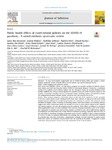Public health effects of travel-related policies on the COVID-19 pandemic: A mixed-methods systematic review
Bou-Karroum, Lama
Khabsa, Joanne
Jabbour, Mathilda
Hilal, Nadeen
Haidar, Zeinab
Abi Khalil, Pamela
Abdul-Khalek, Rima
Assaf, Jana
Honein-AbouHaidar, Gladys
Abou Samra, Clara
Hneinyg, Layal
Al-Awlaqi, Sameh
Hanefeld, Johanna
El-Jardali, Fadi
Akl, Elie A.
El Bcheraoui, Charbel
Objectives: To map travel policies implemented due to COVID-19 during 2020, and conduct a mixed methods systematic review of health effects of such policies, and related contextual factors.
Design: Policy mapping and systematic review.
Data sources and Eligibility Criteria: for the policy mapping, we searched websites of relevant government bodies and used data from the Oxford COVID-19 Government Response Tracker for a convenient
sample of 31 countries across different regions. For the systematic review, we searched Medline (Ovid),
PubMed, EMBASE, the Cochrane Central Register of Controlled Trials and COVID-19 specific databases. We
included randomized controlled trial, non-randomized studies, modeling studies, and qualitative studies.
Two independent reviewers selected studies, abstracted data and assessed risk of bias.
Results: Most countries adopted a total border closure at the start of the pandemic. For the remainder
of the year, partial border closure banning arrivals from some countries or regions was the most widely
adopted measure, followed by mandatory quarantine and screening of travelers. The systematic search
identified 69 eligible studies, including 50 modeling studies. Both observational and modeling evidence
suggest that border closure may reduce the number of COVID-19 cases, disease spread across countries
and between regions, and slow the progression of the outbreak. These effects are likely to be enhanced
when implemented early, and when combined with measures reducing transmission rates in the community. Quarantine of travelers may decrease the number of COVID-19 cases but its effectiveness depends
on compliance and enforcement and is more effective if followed by testing, especially when less than 14
day-quarantine is considered. Screening at departure and/or arrival is unlikely to detect a large proportion
of cases or to delay an outbreak. Effectiveness of screening may be improved with increased sensitivity
of screening tests, awareness of travelers, asymptomatic screening, and exit screening at country source.
While four studies on contextual evidence found that the majority of the public is supportive of travel
restrictions, they uncovered concerns about the unintended harms of those policies.
Dateien zu dieser Publikation

